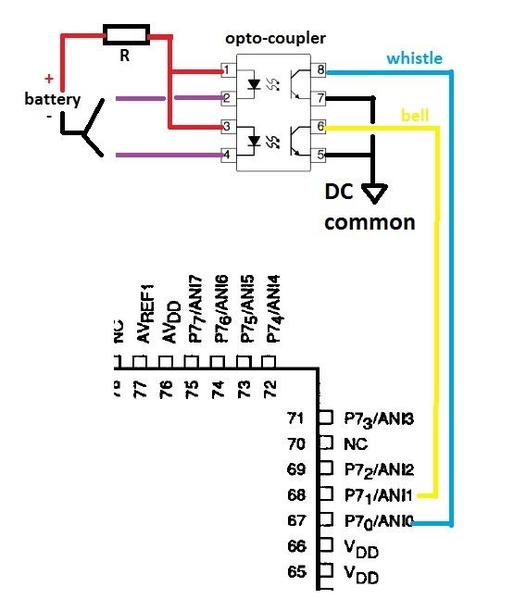So here's my progress so far.

Based on the datasheet, I measured the A/D reference voltage on the D7823 chip (pin 77 or AVref1) and it is 5.0V DC...so I'm looking for an analog voltage in the 0-5V range that changes with DC offset on the track. I could not find a 0-5 VDC signal on the 2x8 inter-connect headers that materially changed with a transformer Whistle or Bell button press. But in examining two of the A/D input pins (AN0 and AN1) I found the following interesting results. With 13.5V AC on the track using a Z-4000, I pressed Whistle and Bell buttons. The Z-4000 put +2.27 V DC (Whistle) and -1.56V DC (Bell) offsets on the track.
AN1 measured: 4.01V, 3.88V, 3.78V for Whistle, none, Bell.
AN0 measured: 3.72V, 3.88V, 3.97V for Whistle, none, Bell.
These are DC voltages though the actual signals are clipped track voltage waveforms (confirmed by an oscilloscope).
So there's some kind of differential behavior with AN1 increasing and AN0 decreasing for a positive DC offset (Whistle button) on the track. I suspect the processor chip might be measuring the delta between the two signals to decide if an offset is present.
The interesting result is I could trigger the Whistle or Bell by simply applying +5V DC or Ground via a 1K resistor to one of the pins. More tests as time-permits...
----------------------
Edit: additional info:
With 13.5V AC on the track using a Z-750, I pressed Whistle and Bell buttons. The Z-750 put +3.15 V DC (Whistle) and -3.33V DC (Bell) offsets on the track...substantially more DC offset than the Z-4000.
AN1 measured: 4.46V, 4.21V, 4.04V for Whistle, none, Bell.
AN0 measured: 4.06V, 4.21V, 4.45V for Whistle, none, Bell.
Again, I was able to trigger the audio by injecting a small current (well under 1 mA) into just one of the A/D pins. The changes in A/D pin voltages in response to button presses increased with the larger track DC offsets; so it's a reasonable indicator that these pins might be the magic nodes. Also the idle voltage (no button pressed) also changed which makes sense since the Z-750 and Z-4000 track voltage waveforms are materially different (chopped vs. smooth sinewave).




















